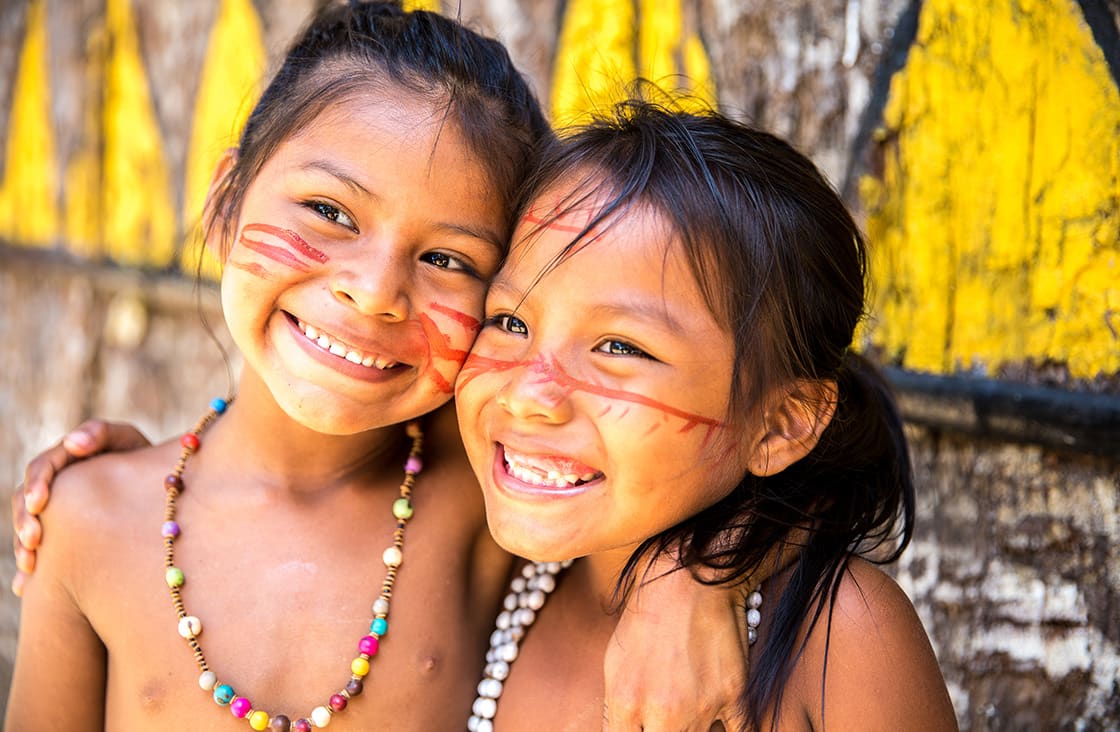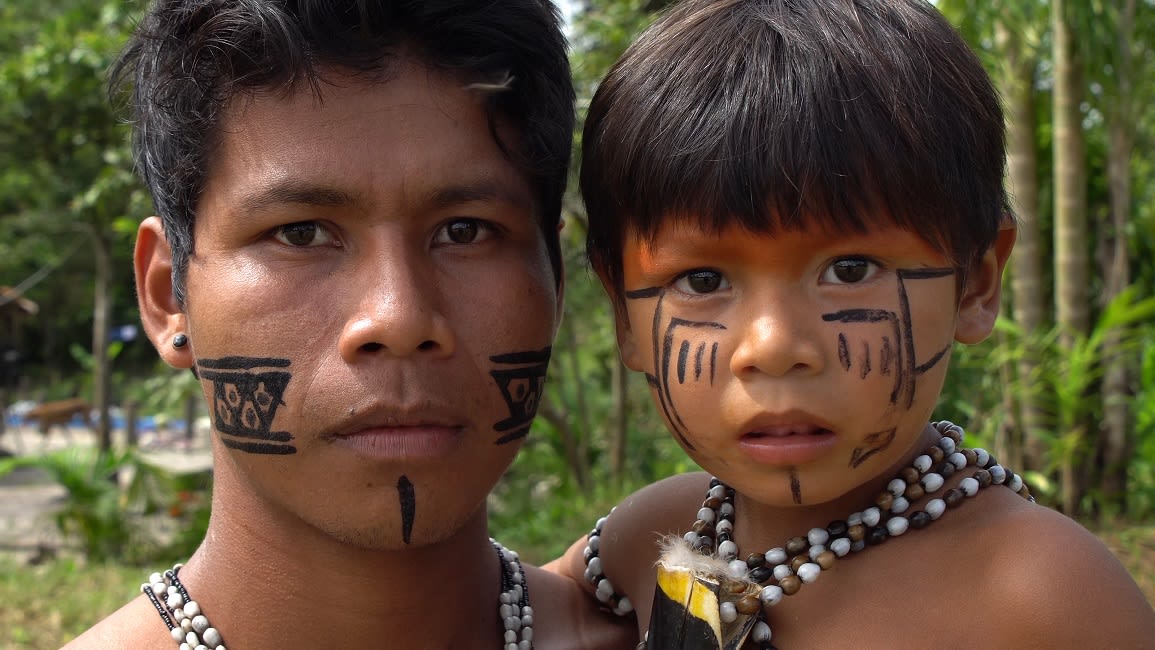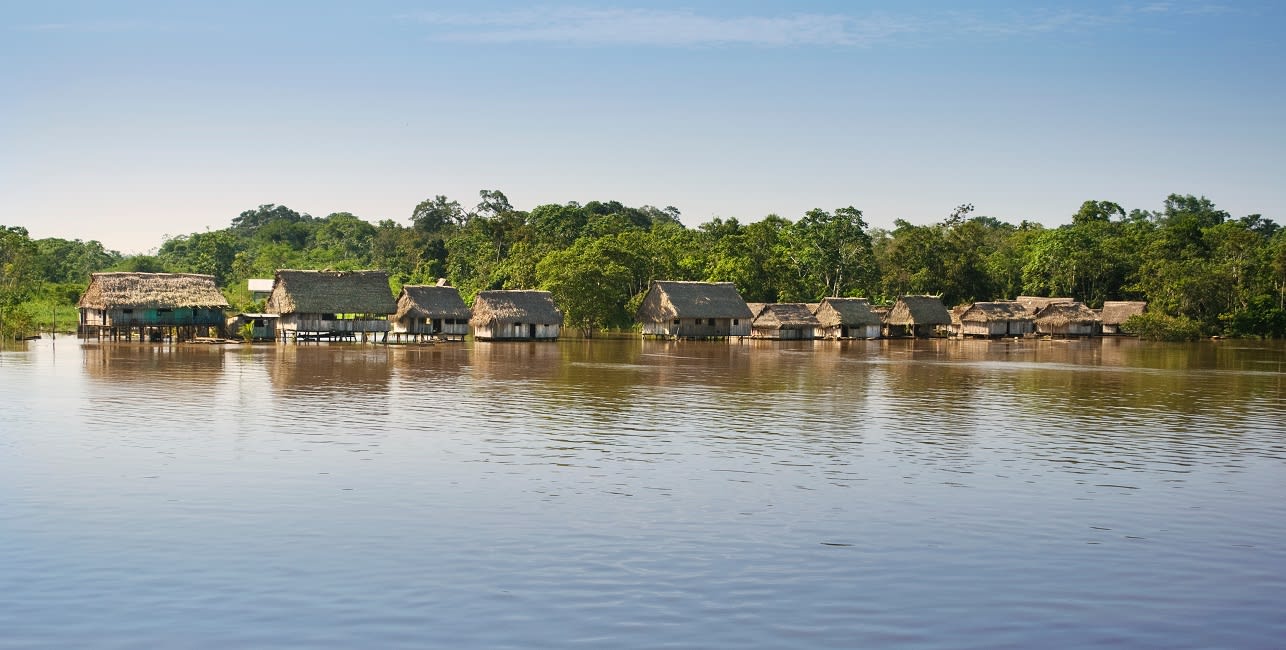
The words ‘Amazon Rainforest’ conjures up images of lush green canopies, exotic wildlife, and tantalizing rivers meandering out of sight. But this tropical paradise is also home to potentially as many as one million indigenous people that live sustainably on the natural resources of the rainforest, as their ancestors have done for thousands of years.
But how do these men and women live in the Amazon basin today? How do their lifestyles differ from our own? And how are they affected by a world that is rapidly changing around them? There are estimated to be over 400 indigenous tribes such as the Yanomamo and Kayapo in the Amazon Rainforest today. Although there are still many things we don’t know about their ways of life, we can piece together an image of their day-to-day lifestyle.

A House Of Yagua Tribe In The Peruvian Amazon
First, however, let’s take a step back in time. We know that the Amazon has been inhabited by indigenous groups for at least 11,200 years and that before the arrival of Europeans in the 16th Century and subsequent persecution of the locals, there were approximately 6.8 million native people (often called the Amerindian population) living in South America. We also know that within the first 100 years of European colonization, this population decreased by a massive 90%.
The majority of this huge decline in numbers was lost due to disease – European explorers had brought with them illnesses like smallpox, measles, and the common cold that the native groups had no immunity to. Those that remained were the tribes that lived deep within the rainforest or those that were pushed there by European persecution, slavery, and warfare.
Today, it’s not just disease that native groups have to fear, but the problems that arise from the legal and illegal exploitation of the forest. Drug trafficking, logging, rubber tapping, mining, ranching, and other deforestation mean they are under mounting pressure to preserve the lands that have long been their home. Indigenous tribes are on the front-line of those affected by the recent catastrophic fires that have ravaged their lands and livelihoods.

Father And Son At An Indigenous Tribe In The Amazon
Most native Amazonians today live in protected areas of the forest known as indigenous lands where they abide by a combination of traditional and modern means. Some tribes have very much adapted to living near 21st-century urban conurbations, making their living through tourism, frequenting local markets for trade, selling handicrafts to tourists, and using western clothing and cooking utensils. Others remain completely shut off from the madness of the modern world – these are known as ‘uncontacted tribes’ (scroll down for more).
Tribal people’s houses are generally communal structures made from wood, bamboo, and straw. Sometimes these round huts can accommodate up to 400 people! Each family has its own fire within these structures, and hammocks strung up around it. In the center, there is an area that is used for feasts and displays. Tribes normally make decisions communally, holding huge discussions where everyone is allowed a voice.
Agriculture and hunting are still crucial skills that are taught to children from an early age. Capybaras, tapirs, crocodiles, monkeys, deer, fish, and turtles are all fair game and are hunted with blowguns, poison-tipped arrows, spears, traps, and more recently guns (if they can be afforded). Over the millennia, indigenous people have accumulated a wealth of expertise on how to coexist sustainably with the wild, skillfully managing the biodiversity of the forest.
Groups either live in the riverside areas that flood in the rainy season (called the ‘varzea’) or on terra firme (dry land further into the forest). Those in the varzea harvest crops like beans, bananas, wild rice, and manioc, making the most of the highly fertile soil, and rich supply of game. Those on dry land practice the ‘slash-and-burn’ method of agriculture, shifting their cultivation from place to place as the soil’s nutrients are depleted.
However, over the past 500 years of European colonization and the modern-day destruction of the habitats surrounding their homes, many Amazonian people have had to adjust to a new way of life. Native groups were forced to no longer be nomadic – now they have to live more sedentary lifestyles, which means that areas of land aren’t given time to recuperate.
Men and women have different roles in local communities – the men have traditional hunter-gatherer roles, while the women run the household, growing crops, caring for children, and cooking. Fishing is something that the whole family contributes to!
Clothing varies from tribe to tribe – the uncontacted tribes are often naked, while the tribes that engage in some way in the modern world either wear loincloths, straw skirts or sometimes even western clothing. Tribal face paint is also worn either as a sign of aggression to scare away enemies, camouflage, or sometimes for religious reasons.
Spirituality is a large part of their lives, and many tribes believe that animal spirits inhabit all things. Some spirits can be malevolent, and shamans inhale the hallucinogens in certain plants to get closer to the spirit world. When tribesmen farm and hunt plants and animals, they do it with a fundamental respect for the spirit of the rainforest and all that dwells within it.

Typical Settlement In Amazonas Landscape,
Although very few on the ground, there still remain a smattering of ‘uncontacted tribes’ that live in isolation, mostly in Brazil and Peru. South American governments have created fairly recent protectionist ‘no contact’ policies to ensure that these tribes are left alone.
The threat of exposing these uncontacted tribes to contagions such as measles or flu is a constant concern – epidemics have had huge effects on native populations in the past, perhaps being the main reason for European success in their conquest of the New World. Both Peru and Brazil have built a web of protected reserves where tribes are safeguarded from exploitation and modern-day diseases.
There is very little known about these primeval groups. We don’t know what language they speak, how many there are, or how they live their lives. Brazil could have as many as 70 uncontacted tribes within the Amazon. But with increasing deforestation and exploitation of the land, some uncontacted tribes have made steps to initiating ‘first contact’. This has thrown protection agencies into chaos – it means they have to rethink their policies and work out how they are going to tackle issues of epidemics, language barriers, territory boundaries, and the general chasm in understanding.
There’s no doubt that the indigenous tribes that live in the Amazon Rainforest have certain ways of life that the remaining seven billion of us on the planet could learn from. Studies have shown that nearly 12 percent of the Amazon’s dry land has been formed gradually by humans, as a result of careful management by native groups. They have learned how to live off the land in a non-extractive way, and survive in the rainforest without destroying it. They have, for millennia, protected one of the most biodiverse lands in the world – the ‘lungs of the world’ – to the benefit of us all.
It’s now possible to take an Amazon vacation to meet and interact with certain tribes who voluntarily engage with tourists, to witness their fascinating traditional way of life, and learn from their vast knowledge of the rainforest.
While Rainforest Cruises aim to provide accurate and up-to-date information, we make no representations as to the accuracy or completeness of any information herein or found by following any link on this site. Rainforest Cruises cannot and will not accept responsibility for any omissions or inaccuracies, or for any consequences arising therefrom, including any losses, injuries, or damages resulting from the display or use of this information.




